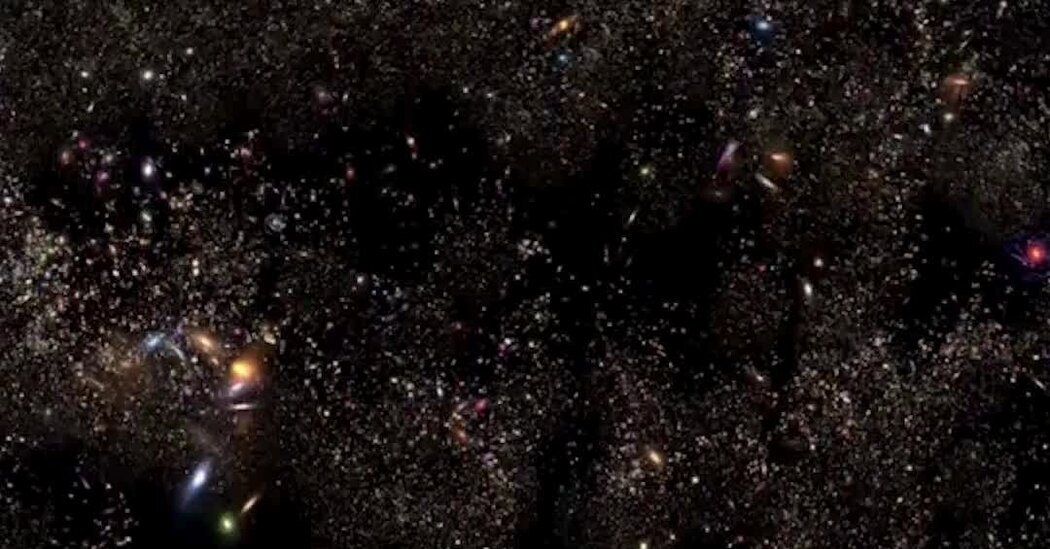On Thursday, astronomers who’re conducting what they describe as the most important and most exact survey but of the historical past of the universe introduced that they may have found a serious flaw of their understanding of darkish vitality, the mysterious power that’s dashing up the growth of the cosmos.
Darkish vitality was assumed to be a relentless power within the universe, each presently and all through cosmic historical past. However the brand new knowledge counsel that it might be extra changeable, rising stronger or weaker over time, reversing and even fading away.
“As Biden would say, it’s a B.F.D.,” mentioned Adam Riess, an astronomer at Johns Hopkins College and the House Telescope Science Institute in Baltimore. He shared the 2011 Nobel Prize in Physics with two different astronomers for the invention of darkish vitality, however was not concerned on this new examine. “It could be the primary actual clue we’ve got gotten in regards to the nature of darkish vitality in 25 years,” he mentioned.
That conclusion, if confirmed, might liberate astronomers — and the remainder of us — from a longstanding, grim prediction in regards to the final destiny of the universe. If the work of darkish vitality have been fixed over time, it could finally push all the celebrities and galaxies to date aside that even atoms can be torn asunder, sapping the universe of all life, mild, vitality and thought, and condemning it to an eternal case of the cosmic blahs. As a substitute, it appears, darkish vitality is able to altering course and pointing the cosmos towards a richer future.
The important thing phrases are “would possibly” and “might.” The brand new discovering has a few one-in-400 probability of being a statistical fluke, a level of uncertainty known as three sigma, which is much wanting the gold commonplace for a discovery, known as 5 sigma: one probability in 1.7 million. Within the historical past of physics, even five-sigma occasions have evaporated when extra knowledge or higher interpretations of the info emerged.
This information comes within the first progress report, revealed as a sequence of papers, by a big worldwide collaboration known as the Darkish Power Spectroscopic Instrument, or DESI. The group has simply begun a five-year effort to create a three-dimensional map of the positions and velocities of 40 million galaxies throughout 11 billion years of cosmic time. It’s preliminary map, based mostly on the primary yr of observations, contains simply six million galaxies. The results were released today at a gathering of the American Bodily Society in Sacramento, Calif., and on the Rencontres de Moriond convention in Italy.
“To date we’re seeing fundamental settlement with our greatest mannequin of the universe, however we’re additionally seeing some doubtlessly fascinating variations that would point out that darkish vitality is evolving with time,” Michael Levi, the director of DESI, mentioned in a press release issued by the Lawrence Berkeley Nationwide Laboratory, which manages the undertaking.
The DESI staff had not anticipated to hit pay grime so quickly, Nathalie Palanque-Delabrouille, an astrophysicist on the Lawrence Berkeley lab and a spokeswoman for the undertaking, mentioned in an interview. The primary yr of outcomes have been designed to easily affirm what was already identified, she mentioned: “We thought that we’d mainly validate the usual mannequin.”
However the unknown leaped out at them.
When the scientists mixed their map with different cosmological knowledge, they have been shocked to search out that it didn’t fairly agree with the in any other case dependable commonplace mannequin of the universe, which assumes that darkish vitality is fixed and unchanging. A various darkish vitality match the info factors higher.
“It’s actually greater than a curiosity,” Dr. Palanque-Delabrouille mentioned. “I’d name it a touch. Yeah, it’s not but proof, however it’s fascinating.”
However cosmologists are taking this trace very severely.
Wendy Freedman, an astrophysicist on the College of Chicago who has led efforts to measure the growth of the universe, praised the brand new survey as “excellent knowledge.” The outcomes, she mentioned, “open the potential for a brand new window into understanding darkish vitality, the dominant element of the universe, which stays the most important thriller in cosmology. Fairly thrilling.”
Michael Turner, an emeritus professor on the College of Chicago who coined the time period “darkish vitality,” mentioned in an e-mail: “Whereas combining knowledge units is hard, and these are early outcomes from DESI, the attainable proof that darkish vitality shouldn’t be fixed is the most effective information I’ve heard since cosmic acceleration was firmly established 20-plus years in the past.”
Darkish vitality entered the dialog in 1998, when two competing teams of astronomers, together with Dr. Riess, found that the growth of the universe was dashing up relatively than slowing, as most astronomers had anticipated. The preliminary observations appeared to counsel that this darkish vitality was performing similar to a well-known fudge issue — denoted by the Greek letter Lambda — that Einstein had inserted into his equations to elucidate why the universe didn’t collapse from its personal gravity. He later known as it his worst blunder.
However maybe he spoke too quickly. As formulated by Einstein, Lambda was a property of space-itself: The extra space there was because the universe expanded, the extra darkish vitality there was, pushing ever more durable and finally resulting in a runaway, lightless future.
Darkish vitality took its place in the usual mannequin of the universe referred to as L.C.D.M., composed of 70 % darkish vitality (Lambda), 25 % chilly darkish matter (an assortment of slow-moving unique particles) and 5 % atomic matter. To date that mannequin has been bruised however not damaged by the brand new James Webb House Telescope. However what if darkish vitality weren’t fixed because the cosmological mannequin assumed?
At difficulty is a parameter known as w, which is a measure of the density, or vehemence, of the darkish vitality. In Einstein’s model of darkish vitality, this quantity stays fixed, with a price of –1, all through the lifetime of the universe. Cosmologists have been utilizing this worth of their fashions for the previous 25 years.
However this model of darkish vitality is merely the only one. “With DESI we now have achieved a precision that enables us to transcend that easy mannequin,” Dr. Palanque-Delabrouille mentioned, “to see if the density of darkish vitality is fixed over time, or if it has some fluctuations and evolution with time.”
The DESI undertaking, 14 years within the making, was designed to check the fidelity of darkish vitality by measuring how briskly the universe was increasing at numerous occasions prior to now. To try this, scientists outfitted a telescope at Kitt Peak Nationwide Observatory with 5,000 fiber-optic detectors that would conduct spectroscopy on that many galaxies concurrently and learn how quick they have been transferring away from Earth.
As a measure of distance, the researchers used bumps within the cosmic distribution of galaxies, referred to as baryon acoustic oscillations. These bumps have been printed on the cosmos by sound waves within the scorching plasma that crammed the universe when it was simply 380,000 years outdated. Again then, the bumps have been a half-million light-years throughout. Now, 13.5 billion years later, the universe has expanded a thousandfold, and the bumps — which are actually 500 million light-years throughout — function handy cosmic measuring sticks.
The DESI scientists divided the previous 11 billion years of cosmic historical past into seven spans of time. (The universe is 13.8 billion years outdated.) For every, they measured the scale of those bumps and how briskly the galaxies in them have been dashing away from us and from one another.
When the researchers put all of it collectively, they discovered that the same old assumption — a relentless darkish vitality — didn’t work to explain the growth of the universe. Galaxies within the three most up-to-date epochs appeared nearer than they need to have been, suggesting that darkish vitality could possibly be evolving with time.
“And we do see, certainly, a touch that the properties of darkish vitality wouldn’t correspond to a easy cosmological fixed” however as a substitute might “have some deviations,” Dr. Palanque-Delabrouille mentioned. “And that is the primary time we’ve got that.” However, she emphasised once more, “I wouldn’t name it proof but. It’s too, too weak.”
Time and extra knowledge will inform the destiny of darkish vitality, and of cosmologists’ battle-tested mannequin of the universe
“L.C.D.M. is being put by its paces by precision checks coming at it from each course,” Dr. Turner mentioned. “And it’s doing effectively. However, when the whole lot is taken collectively, it’s starting to look that one thing isn’t proper or one thing is lacking. Issues don’t match collectively completely. And DESI is the newest indication.”
Dr. Riess of Johns Hopkins, who had an early take a look at the DESI outcomes, famous that the “trace,” if validated, might pull the rug out from different cosmological measurements, such because the age or measurement of the universe. “This end result could be very fascinating and we must always take it severely,” he wrote in his e-mail. “In any other case why else can we do these experiments?”
Source link








